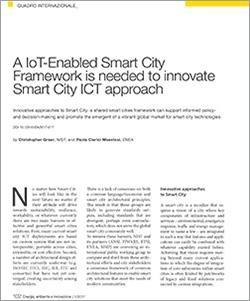
A IoT-Enabled Smart City Framework is needed to innovate Smart City ICT approach
by Christopher Greer, NIST, and Paola Clerici Maestosi, ENEA
DOI 10.12910/EAI2017-017
Innovative approaches to Smart City: a shared smart cities framework can support informed policy- and decision-making and promote the emergent of a vibrant global market for smart city technologies
No matter how Smart Cities will look like in the next future, no matter if their attitude will drive towards sustainability, resilience, workability, or whatever: currently there are two main barriers to effective and powerful smart cities solutions. First, many current smart city ICT deployments are based on custom system that are not interoperable, portable across cities, extensible, or cost effective. Second, a number of architectural design efforts are currently underway (e.g. ISO/IEC JTC1, IEC, IEE, ITU and consortia) but have not yet converged, creating uncertainty among stakeholders.
There is a lack of consensus on both a common language/taxonomy and smart city architectural principles. The result is that these groups are likely to generate standards outputs, including standards that are divergent, perhaps even contradictory, which does not serve the global smart city community well.
To remove these barriers, NIST and its partners (ANSI, FIWARE, ETSI, ENEA, MSIP) are convening an international public working group to compare and distil from these architectural efforts and city stakeholders a consensus framework of common architectural features to enable smart city solutions that meet the needs of modern communities. …

